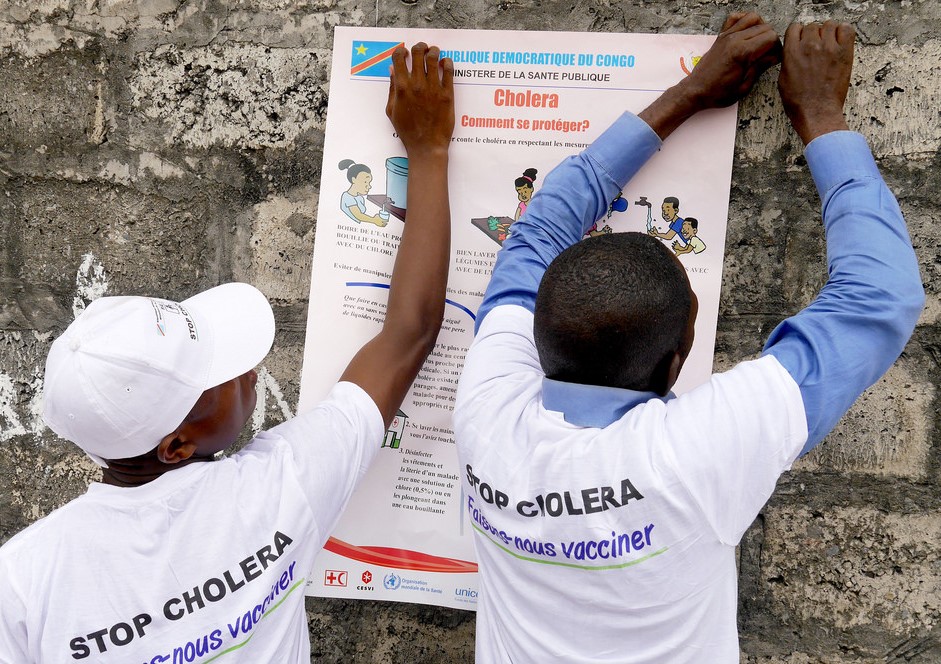“Climate change could increase cholera rates”
January 29 Climate change is a fast growing threat to human health, writes Nancy Saili, 25, a Commonwealth Correspondent from Solwezi in Zambia, as she describes the link between extreme weather and changing disease patterns.
Climate change is a fast growing threat to human health, writes Nancy Saili, 25, a Commonwealth Correspondent from Solwezi in Zambia, as she describes the link between extreme weather and changing disease patterns.
As the world continues to experience extreme weather events such as floods, droughts and heat waves, human health will be even more affected due to the changes in infectious disease patterns, air pollution and food insecurity.
Increases in world temperatures could lead to increased heat stress and high rates of skin diseases such as cancer. The after-shocks of climate events could have serious impacts on the mental health of victims, and air pollution could lead to increased respiratory problems for many people around the world.
In Africa, many countries are suffering health consequences including injury, death, ill-health, high mortality and compromised mobility due to impacts of climate change. Poverty, conflict and weak institutions are some of the factors that limit the capacity of many countries to deal with additional heath challenges resulting from climate change.
Among these is the recent increase in cholera outbreaks in vulnerable countries, not only in Africa, but also across the globe. Yemen, for example, is battling what is being called the ‘World’s Worst Cholera Outbreak’, that has led to thousands of deaths.
Cholera is a bacterial disease caused by Vibrio Cholerae, which is known to thrive in aquatic environments. It is spread through contaminated food and water. In most African countries, lack of proper filtration systems to treat contaminated water is compounded during flooding and in turn gives rise to the spread of the disease. The impact of the disease is worsened by the fact that most of the vulnerable areas have many people crowded into small quarters. This in turn promotes fast-spreading epidemics.
According to a report released by the Wildlife Conservation Society (WCS), cholera is among 12 deadly diseases that climate change is likely to worsen. Cholera has long been known to be the result of poor sanitation, often affecting the most impoverished areas without access to healthcare. Research now suggests that there is a link between climate change and the spread of cholera. This research shows consistencies between cholera outbreaks and measurement of high temperatures and large rainfall.
The weather has an impact on even the smallest of organisms. With 2017 being the second hottest year on record, bacterium and viruses that thrive on heat have become more active, altering the incidence, range and seasonality of many existing health problems. The increase in temperature and flooding events has provided perfect conditions for reproduction for many viruses.
In 2017, D.R. Congo remained the most affected country in West and Central Africa, accounting for 88 per cent of cholera cases. Other countries affected included Nigeria, Chad, Tanzania, Kenya and its immediate neighbour, Zambia. In October 2017, Zambia’s Minister of Health declared an outbreak of cholera in the capital, Lusaka. The initial outbreak period was in the dry season of September through to October, however toward the onset of the rainy season in November 2017 the number of reported cases began to increase. The results of tests conducted on water sources in Lusaka showed that nearly 42 per cent of them were contaminated with either faecal coliforms or Escherichia Coli.
Lusaka city has many areas with inadequate water, sanitation and storm water infrastructure, and as a result these areas experience flooding during the rainy season. This provides an environment that favours the spread of disease. Most of these areas are densely populated, with numerous open markets and street vending. The crowding and lack of infrastructure results in increased sources of infection from not only contaminated water but also contaminated food and poor hygiene practices.
It is devastating to see how fast cholera spread in a period of three months, and saddening to see lives lost. The outbreak has a had a serious effect on children whose immune systems are vulnerable. School-going children have also been affected by the outbreak. As of January 2018, due to an increase in recorded cases and deaths, the Minister of Health in a joint statement with his Education counterpart announced that all schools around the country would remain closed until the situation was under control. Students will fall behind in their school work, and students in examinations classes who have less than a year to go will be especially affected.
Although Zambia’s most affected area was Lusaka province, sporadic cases of cholera in various parts of the country were recorded. For this reason, all schools country-wide delayed in opening, out of fear that students in boarding schools coming from affected areas – as well as students going to boarding schools in affected areas – would worsen the situation. Gatherings of more than five people were discouraged for the same reason.
The outbreak has affected people in everyday life, from fearing to buy rainy season produce like freshly picked mangoes, maize and groundnuts to avoiding public get togethers. Many must transfer funds earmarked for other uses such as children’s school fees to cover medical bills for ill family members, or even pay funeral costs. The stigma associated with the disease and its survivors lingers on.
Although the situation is currently under control due to quick public health response and help from the World Organisation of Health, the possibility of future outbreaks is still high. The Ministry of Health in collaboration with WHO and other partners has taken measures to prevent the spread of the disease. Cholera treatment centres have been established, and many facilities have continued with active surveillance, chlorine distribution, contact tracing and environmental health monitoring. Health workers are also receiving updated Cholera Outbreak Guidelines and standard operating procedures.
Garbage collection has been intensified in most parts of the affected areas. Water Sanitation and Hygiene (WASH) interventions to improve water supplies in affected areas have been adopted. Other public places remain closed until their conditions meet health standards.
However, fighting climate change is, in the end, the key to dealing with rising health threats. It provides a global opportunity to protect human health, especially for poor and vulnerable populations who will suffer the most from these impacts.
Early action on climate change will also produce health benefits for many people all around the world. A reduction in fossil fuel burning would increasingly reduce respiratory diseases, while cleaner transport systems would help achieve a decline in poor air quality in the environment. Proper management of land and water would have positive outcomes for the agricultural sector and help reduce poverty and food insecurity issues. A healthy climate is a strong foundation for healthy people and communities.
Photo credit: MONUSCO Zone de Pakadjuma, Province de Kinshasa, RD Congo: Des mobilisateurs sociaux mettent en place des affiches sur les mesures clés pour éviter le choléra dans la zone de Pakadjuma touchée par l’épidémie de choléra. via photopin (license)
Resources: https://www.passporthealthusa.com/2017/12/
https://www.ncbi.nlm.nih.gov/pmc/articles/PMC2744514/
https://edition.cnn.com/2017/02/16/health/climate-change-deaths-health-al-gore-bn/index.html
https://www.scientificamerican.com/article/twelve-diseases-climate-change-may-make-worse/
http://www.who.int/csr/don/11-december-2017-cholera-zambia/en/
http://www.irinnews.org/news/2009/09/22/cholera-patients-battle-stigma
http://mobile.reuters.com/article/amp/idUSKBN1ET1JF
http://www.africanews.com/2018/01/04/zambia-cholera-outbreak-delays-2018-schools-calender//
…………………………………………………………………………………………………………………
About me: I am very passionate about the environment, human rights, young girls and women related issues. I am a writer and hope to teach creative writing in the future. I love art, photography and film and like to use them as tools to address various issues facing us all.
I am currently a PEPFAR DREAMS ambassador, a youth voice at Global Dialogues Trust and a Climate Tracker/coordinator at the climate tracker Africa hub.
…………………………………………………………………………………………………………………
Opinions expressed in this article are those of the author and do not necessarily represent the views of the Commonwealth Youth Programme. Articles are published in a spirit of dialogue, respect and understanding. If you disagree, why not submit a response?
To learn more about becoming a Commonwealth Correspondent please visit: http://www.yourcommonwealth.org/submit-articles/
………………………………………………………………………………………………………………




